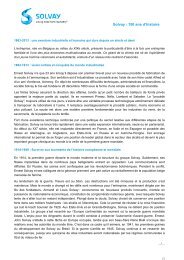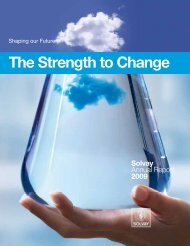solvay_live243_p02a04 somEdito
solvay_live243_p02a04 somEdito
solvay_live243_p02a04 somEdito
You also want an ePaper? Increase the reach of your titles
YUMPU automatically turns print PDFs into web optimized ePapers that Google loves.
103495 104912<br />
NANO-COMPOSITE TECNOFLON ® PFR<br />
FOR SEMICON APPLICATIONS<br />
PURELY COMPETITIVE<br />
The demand for high quality<br />
fluoropolymers entails the use<br />
of compounds that meet the new criteria<br />
of macromolecular chemistry. The resulting<br />
challenge lies in the capacity to control the<br />
macromolecular structures and to produce<br />
compounds that combine the polymers and<br />
highly dispersed fillers. That is the case of<br />
our Tecnoflon ® perfluoroelastomers, which<br />
have the highest chemical and thermal<br />
resistance capacities of all the elastomers on<br />
the market. They have been produced<br />
through the combination of different<br />
technologies held by Solvay Solexis. It is<br />
important to point out that the nanoparticles<br />
that have gone into the manufacture<br />
of the Tecnoflon ® PFR 5910 and PFR 5920 are<br />
effectively dispersed, thanks to a proprietary<br />
co-coagulation technology, and not<br />
agglomerated as is the case for several<br />
materials unduly described as nanocomposites.<br />
As is proven by their transparency. These<br />
ultra-clean and ultra-resistant products are<br />
used as joints in equipment earmarked for<br />
the plasma etching of silicon wafers, which<br />
necessitates the highest degree of purity,<br />
the absence of metallic ions, good sealing<br />
properties and exceptional chemical<br />
resistance qualities. The first industrial sales<br />
of Tecnoflon ® PFR started in 2005 in the semiconductor<br />
sector. However, its performances<br />
destine it for other segments such as the<br />
pharmaceutical, food, medical and aerospace<br />
industries, and for use in all processes that<br />
call for a material of an extreme purity<br />
combined with good mechanical properties.<br />
> Vincenzo Arcella; Margherita Albano; Marco Apostolo;<br />
Stefano Arrigoni; Giovanni Comino.<br />
> SBU SPECIALTY POLYMERS<br />
SOLV-X, A NEW STABILIZER FOR PULP BLEACHING<br />
A PRODUCT THAT MAKES<br />
LIFE EASIER<br />
FOR THE PAPER INDUSTRY<br />
The paper industry has long since been<br />
using hydrogen peroxide as a pulp<br />
bleaching agent. The bleaching process calls<br />
for the use of stabilisers (silicates) to avoid<br />
the decomposition of the peroxide under<br />
the effect of the metallic ions (manganese<br />
and iron) which come from the soil in which<br />
the tree has grown. The action of these ions<br />
not only reduces the quality of the bleaching<br />
but also affects the characteristics of the<br />
pulp. Sodium silicate is introduced into<br />
the process in order to counter these<br />
negative effects. But given that the silicate<br />
precipitates in the presence of calcium,<br />
industrialists who use hard water face other<br />
problems, since they frequently have<br />
to replace or clean the equipment and<br />
are confronted with difficulties when using<br />
recycled water in the process. To overcome<br />
all these problems, Solvay has developed<br />
a new product, the SOLV-X, based on<br />
a polyhydroxyacrylate molecule. Two<br />
variants of the product are proposed, one<br />
which is highly active and another less<br />
active, to meet as much as possible the needs<br />
of the paper industries. The product is<br />
biodegradable, which tangibly reduces the<br />
environmental impact. With SOLV-X, Solvay<br />
offers an alternative to silicate with a new<br />
product. One single competitor is present on<br />
this niche market. A partnership has been set<br />
up with the chemical company Clariant<br />
for the development and subsequent<br />
world-wide production of SOLV-X. Research<br />
is also currently underway to check whether<br />
the SOLV-X can be also used for paper<br />
de-inking.<br />
> Rodney Soccombe; Pierre Dournel;Anna Mannaerts.<br />
> SBU H 2O 2<br />
New business<br />
J U L Y 2 0 0 6<br />
23




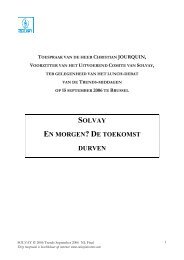
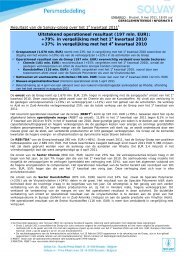

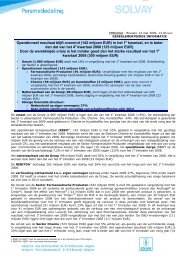
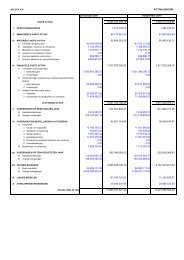

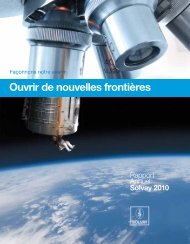
![PROC.1 [LETTRE] - Solvay](https://img.yumpu.com/16585746/1/184x260/proc1-lettre-solvay.jpg?quality=85)
